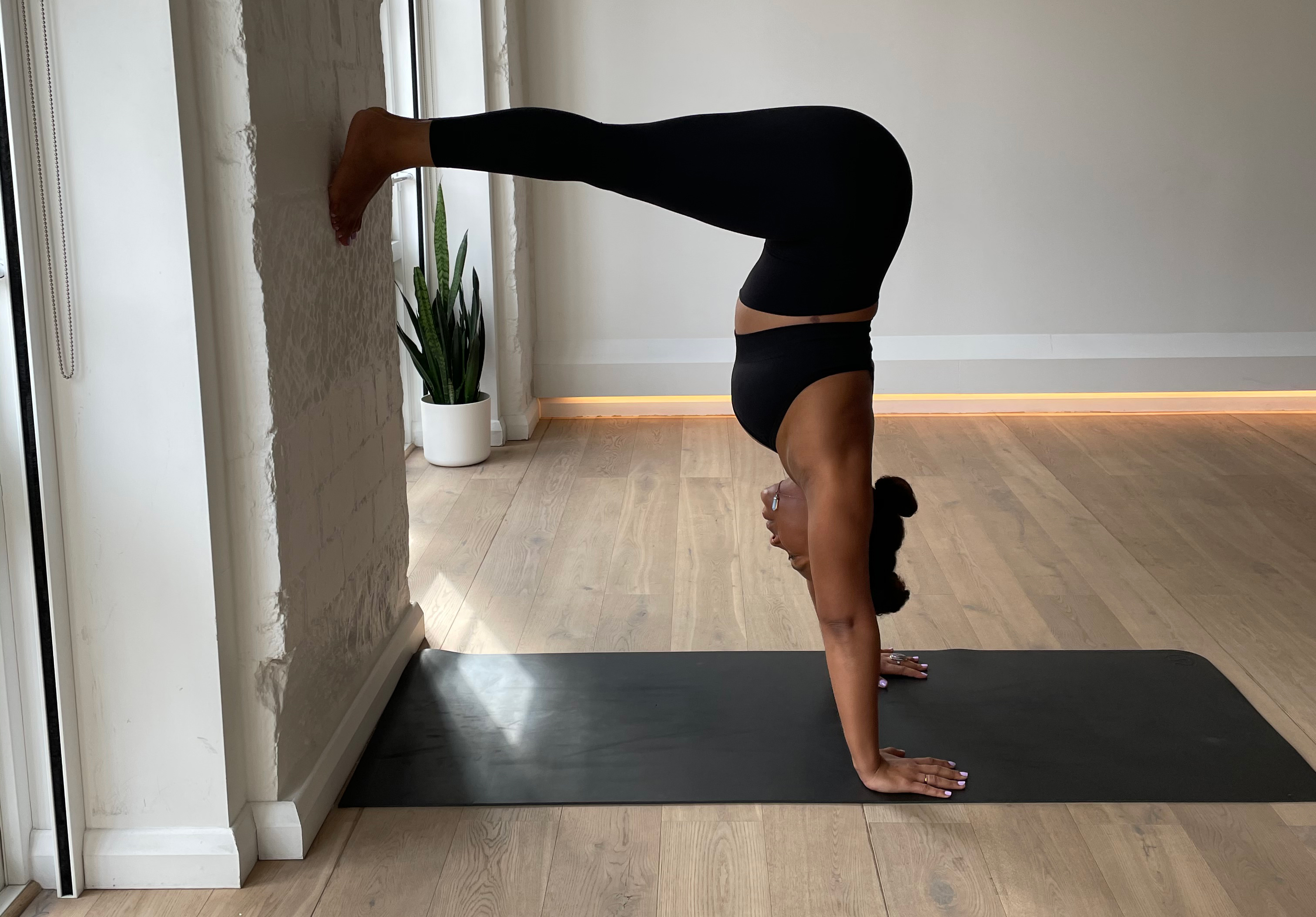Learn to do a handstand hold in one month: Master this calisthenics move
How to perform the handstand hold, an impressive feat of calisthenics


Gone are the days when performing a handstand in the school playground was easy as pie. As we get older, wear and tear on our bodies, loss of bone mass and fear of falling over make many of us turn away from this classic calisthenics stunt, but there are plenty of advantages to performing this childhood favourite.
A handstand is one of the most beneficial upper body exercises you can do, due to the fact that it targets your arms, shoulders and upper body, as well as strengthening your core, wrists and spine. It's an awesome way to supplement your conventional resistance training with the best adjustable dumbbells and best resistance bands. Handstands also increase your overall balance, which is crucial area of concern as we age, helping to prevent falls and promoting bone health and circulation.
Kat Farrants, Founder of the online yoga platform Movement for Modern Life, said: "You might have a love-hate relationship with handstands, but there’s no denying that this posture works your whole body and provides a well-rounded and fun way to workout.
"Getting upside down challenges us both physically and mentally, but the reward can be an energy reset and a sense of empowerment. Physically training for handstands helps to refine your alignment and posture, build all round body strength, and improve your flexibility."
If the thought of a handstand practise popping up in your yoga class brings you out in a cold sweat, or you're keen to perfect your form before you attempt it, then fear not. We have compiled the ultimate beginners guide to handstands, breaking down this calisthenics move into simple stages to get you head over heels in one month flat.
Be sure to remember that persistence and patience are the perfect formula to a handstand, so be kind to yourself and don't expect to be an expert overnight. Handstands are meant to be fun, so enjoy this instant mood-boosting exercise and the health and strength benefits that come with it.
How to prepare your body to do a handstand
"Handstanding requires the entire body to be activated, arms, core, legs and mind! It's important to have a plan with this in mind," says Darvina Plante, a yoga teacher at boutique fitness studio Psycle and self-confessed handstand enthusiast.
Start your week with achievable workout ideas, health tips and wellbeing advice in your inbox.
"If you want to have longevity in your handstand, your warm up is more important than the handstand itself!" explains Darvina. You can see our warm-up instructions in the video below:
- Flashing Lights: Extend your arms out straight ahead of you and start opening and closing your hands. Start with 10 seconds then shake the hands and wrists out, repeat the move twice more. Eventually working up to three 30 second sets.
- Palms Up: Starting in a table top position hands under the shoulders, lift the heel of the hands up only and then back down. Aim for 10 reps then rest for 20 seconds before relating for 3 rounds.
Learning to engage your core
Darvina reveals "A strong core is essential for handstanding and especially if you're on the quest for the handstand press you will need a core of steel to find the control to sustain these kinds of skilful actions."
- Body Weight Core Exercise: Lay on your back and bend your knees up so they are hovering over your torso. Extend your right leg out straight and hold for three breaths. Draw the right leg back in and repeat on the left leg.
- Extend both legs out and hold x10 breaths. Rest and repeat for another 5 rounds.
- Dumbbell Core Exercise: Progressing from the body weight core exercise, lay on your back again and bend your knees up and root your feet down. Reach your arms overhead with light dumbbells in each hand.
- Draw both knees into the chest and lift the head and shoulders off the mat and hold for 10 breaths. Rest and repeat the set again for 3 rounds.
Handstand progressions
Beginner's handstand

- Sit facing the wall with your legs extended straight out in front of you and your feet planted on the wall,
- Place your hands under your shoulders and switch the body to be facing away from the wall (you may need to adjust the hands or feet slightly here according)
- With your hands underneath your shoulders looking in between the hands, start to walk your feet up the wall.
- Aiming for an L shape with the body with your feet firmly pressed against the wall, shifting more weight into the hands.
- Hold for 10 seconds first attempt and then slowly up to a minute or as long as you can hold for.
Classic L-Shape Handstand
- Once you’ve got to grips with the beginners move, start again in the same position.
- Lift one leg skyward while the other foot is still planted on the wall.
- Come to the ball of the grounded foot and repeat with the opposite leg.
- Play with the grounded foot coming away from the wall finding your handstand.
- Repeat the move again on the opposite side.
- Build you time up slowly from 10 seconds up to a minute.
Full handstand

- Start in a classic downward facing dog yoga position.
- Switch your gaze between your hands and place the weight of your torso on your upper arms.
- Lift one leg skyward (come on to the ball of the grounded foot)
- Take hops off of the grounded off finding a hop, try this x5 times each side and switch
- The grounded leg is working towards meeting the leg that is already lifted to find your straight leg handstand
- Find your balance and hold for 5 seconds on your first attempt and then build the time up for as long as you can.
Further reading:
If you're after more calisthenics exercises, it's worth learning how to do pull-ups and dips, which will increase the stabilisation muscles in your shoulders. Meanwhile, reminding yourself how to do a plank is great for more core engagement.
Kirsty is an accomplished journalist specialising in the wellness industry. She has previously written for titles including Grazia, Popsugar, Metro.co.uk, Elle UK and the Sunday Telegraph. You’ll find her running around Windsor Great Park at 6am most mornings (before her toddler, Clementine Lilac, wakes up), followed by a virtual barre class with the team at Psycle London – where that barre burn is just so addictive. Kirsty loves to stock up on new activewear; because, let’s face it, you can never have too many pairs of sculpting leggings. She's always keen to try/endure the latest workouts to come to London. Kirsty also enjoys rustling up nutritious family meals and indulging in her newfound hobby: flower pressing.
